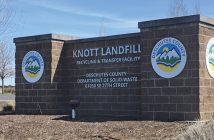(Photo by Timothy Park)
Inspired by Their Studies, Former COCC Math Students Find a Calling at the Head of the Class
Monday mornings are no match for Sean Rule. In a festive shirt patterned in different dry fly designs and a pair of well-loved, neon-green Crocs, his hair mushrooming up above his visor, the math professor moves and talks in quick bursts, leveling the early hour with his enthusiasm. He somehow seems to get more oxygen than those around him.
Seated at computers in the Barber Library’s computer lab, students of Rule’s 8am Math and Society class are getting their minds in gear. Most are groggy; a few yawn. Their first task of the day is a linear modeling problem that requires a cost comparison of whether to “buy” an inefficient, but cheaper, used Ford Escape V-6 or plunk down for a pricier hybrid model of the same vintage. They dive in — some deeper than others.
“I’m a little lost,” admits a male student rather quickly. “That’s OK,” Rule replies, sweeping in. But he doesn’t hover or linger or dole out a quick fix. He engages the student with a question, reframing the problem and then bursts on, addressing the whole class. He scribbles up a few whiteboards — and a window — with the lesson’s salient points, constantly soliciting input, and continues to move, his hands puncturing the air like a martial arts demo.
By now, more of the students are beginning to participate. The class ebbs more towards a dialogue than a lecture. With his positivity, his inclusive nature, Rule connects. He makes the discussion matter. It seems that even the most reticent students don’t stand a chance in this learning environment.
COLLABORATIVE SPIRIT
With 12 full-time professors, and a total of 31 faculty and staff, COCC’s mathematics department is the largest at the college within a single discipline. Their curriculum — covering everything from pre-college math to vector calculus — has a hand in most educations at COCC. Whether you study aviation or massage therapy, there is a requisite math class to take.
But the size and scope of the department doesn’t splinter their focus. Kathy Smith, math professor and department chair, says they emphasize their shared mission through things like routine teaching discussions and ensuring that full-time professors take turns teaching both pre-college and college-level coursework. “That’s part of our collaborative spirit,” she says.
That collaborative spirit is found in other areas, too. In the Grandview Building, home to the department, there’s a mammoth blackboard in the lobby that always has a new problem written on it. Students will stop and stare, ponder for a while, maybe scrawl a solution. This can trigger some weeks-long, back-and-forth chalk chatter among students and faculty before the problem is solved.
Around the corner and down the hall, there’s a collection of framed T-shirts on the walls from the department’s annual high school Math Contest (see Fun with Numbers). It’s a tribute to a long-standing collaboration.
Michael Lopez, who graduated from COCC in 2014, was drawn to this collaborative culture. “I remember just wandering the halls of Grandview, and the staff and faculty would invite me in and just talk with me to make sure things were going well, to tell me a story or joke or to hear mine,” he says. Soon, the department was turning this former U.S Marine’s favorite subject into a true passion.
“Jill Plattner was the very first person in the math world to take me under her wing,” he recalls. Plattner encouraged him to be a class grader, and later a tutor and teacher. She found a way to involve him. With inspiration from other instructors, like Liz Coleman, Lopez went on to establish a math club at the college: Math Leaders of Central Oregon, or Math L.O.C.O. “Our main goal was to foster an appreciation of mathematics in the community,” he says. The club held events and presentations to explore creative aspects of math — a new chapter in the collaborative spirit.
Lopez attended Oregon State University (OSU) to earn his bachelor’s degree in mathematics in 2017 and is now working on his master’s degree in math at OSU. He plans to attend a Ph.D. program and eventually inspire his own college students (though he’s already making headway as a teaching assistant). “I really have no idea where I want to teach afterward, but I know that it would be amazing to be in a place that had a department such as COCC,” he adds.
Patty Hammer decided that’s exactly where she wanted to be. A graduate of 2005 — involving nine years of tenacious commitment to earn her associate’s degree — she later earned her bachelor’s degree from the University of Oregon and returned to COCC to teach, currently as an adjunct instructor.
“I have always had a love-hate relationship with math,” Hammer admits. “My father was a math teacher and I used to help him grade papers, so you might say it’s in my genes.” But she bolted from math after that. Her dyslexia, she thinks, was the culprit.
Undiagnosed until she was 36, Hammer says the disorder overwhelmed her affinity for numbers and puzzles. She instead entered the printing profession, where working with press negatives always made sense to her back-to-front perspective. But a few factors, including the sense that she had “settled for what was safe,” eventually prodded her to begin taking classes at COCC.
Along the way, Hammer’s instructors observed she was good at explaining math to her classmates. So they began to involve her in departmental things, like setting up the lab for online students and helping with the Math Contest. It encouraged her to overcome her obstacles. “All of them were involved in pushing me in a direction that I would not admit I was passionate about, but really loved to do,” she says.
Today, Hammer, who teaches developmental courses, is right where she wants to be. “There is nothing more exciting than to help others see what I can see in them,” she says. “And to watch the sparkle come into a person’s eyes when they, too, find
their passion.”
WHEN IT CLICKS
Andrew Jensen thinks the whole “math person” thing is a myth. And he should know. “Ironically enough, before going to COCC, I really struggled,” shares the former student, who now teaches geometry and algebra at Madras High School. “Math never really ‘clicked.’”
But at COCC, something undeniably did. First, while pursuing exercise science studies, and later, going after a biology degree, Jensen discovered in his required math classes that the subject took on new life.
It started with Pat Sunset’s algebra class, he remembers, and continued with Sean Rule’s statistics course — a game changer. “Sean helped me find my confidence as a mathematician and taught me how to be a critical thinker,” he shares. It was more about the “why,” he explains, and the thinking behind the mathematics than the memorizing of content. After confronting his college nemesis — calculus — and earning perfect marks under professor Charlie Naffziger, Jensen realized that while he’d never imagined himself as a math person, the material was illuminated in a new way, made more relevant. He earned a bachelor’s degree in biology at OSU in 2015, followed by a teaching degree, and took his keen interest in math to the head of the class. His students will soon explore Geometry in Construction, a hands-on course that employs math to build a house—something that honors the “why” that first inspired him.
Like Jensen, Jeff Schiedler’s entry into the field was somewhat unplanned, but ultimately irresistible. The Redmond High School math teacher, who earned his associate’s degree in 2007, originally set out to be an engineer. His time at COCC nudged him in another direction. He now guides students through calculus, geometry and physics.
“My years at COCC helped develop a passion for mathematics,” says Schiedler. He attained his bachelor’s degree at the University of Oregon and went on to earn a master’s in teaching from George Fox University. “Teachers like Doug Nelson and Charlie Naffziger stand out as individuals that I aspired to be like. They were incredibly personal, motivating
and engaging.”
THE BIGGER EQUATION
Making mathematics engaging and approachable is helping these and other students succeed. But the department’s impact has larger consequences, too.
These days, math minds are more and more in demand. The U.S. Bureau of Labor Statistics reports that employment of math occupations is projected to skyrocket by 28 percent between 2016 and 2026. But according to new Pew Research Center findings, there’s a nagging perception about math: 52 percent of adults say the main reason young people don’t pursue STEM degrees, like mathematics, is they consider these subjects too hard.
The perception of “math as tough” is one that needs to be dispelled — or at least lessened. Certainly, math is challenging and exacting. But it’s also extremely rewarding and enjoyable. And with the right guidance, with elements of inspiration, math can prove to be a favorite subject that opens minds, opens doors and, ultimately, empowers lives.





